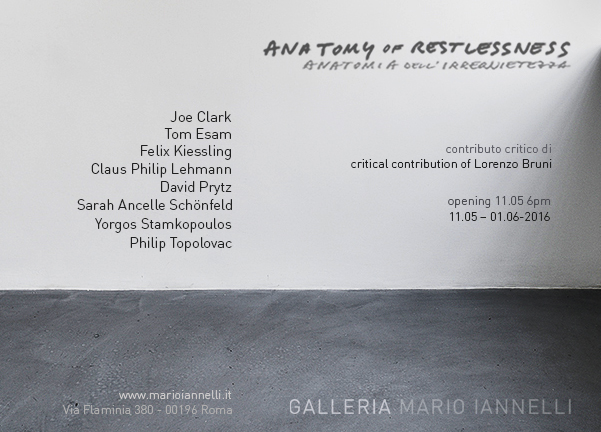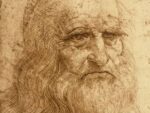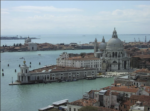Anatomy of Restlessness (Anatomia dell’irrequietezza)

Gli artisti invitati hanno realizzato appositamente per l’occasione due nuove opere a testa che indagano, per mezzo di tecniche differenti, i limiti e l’identità della superficie del “soggetto immagine” nel momento del passaggio di consegne dal sistema analogico a quello digitale.
Comunicato stampa
Anatomy of Restlessness (Anatomia dell’irrequietezza)
Joe Clark, Tom Esam, Claus Philip Lehmann, David Prytz, Sarah Schönfeld, Yorgos Stamkopoulos, Philip Topolovac, Felix Kiessling
Contributo critico di Lorenzo Bruni
La Galleria Mario Iannelli presenta mercoledì 11 maggio, dalle ore 18:30 in Via Flaminia 380 a Roma, la collettiva dal titolo Anatomy of Restlessness (Anatomia dell’irrequietezza) con il contributo critico di Lorenzo Bruni.
Gli artisti Joe Clark, Tom Esam, Claus Philip Lehmann, David Prytz, Sarah Schoenfeld, Yorgos Stamkopoulos, Philip Topolovac e Felix Kiessling hanno realizzato appositamente per l'occasione due nuove opere a testa che indagano, per mezzo di tecniche differenti, i limiti e l'identità della superficie del “soggetto immagine” nel momento del passaggio di consegne dal sistema analogico a quello digitale. Le sedici opere inedite spaziano dalla macchina celibe Time drawing di Felix Kiessling, che misura la durata della mostra per mezzo di un gesso che disegna in maniera reitera un cerchio su di una base, all'installazione Snake dance di Sarah Schönfeld in cui una pelle di serpente è animata da un'aspirapolvere acceso il cui tubo attraversa unendo/sfondando due pareti della galleria; dalle immagini fotografiche Asset Management di Joe Clark di superfici illuminate come rendering nello spazio virtuale della computer grafica al Je suis Esam di Tom Esam che consiste in un banner su cui un'immagine in bianco e nero di una folla di manifestanti porta in marcia il nome dell'artista evidenziato in rosso.
Questi sono solo alcuni degli esempi degli interventi, tutti all'insegna “dell'evento minimo”, che puntano a caratterizzare lo spazio espositivo in modo da non produrre solo una mostra collettiva, bensì “un'esperienza laboratoriale” dalle differenti implicazioni psicologiche e fisiche, personali e collettive, tra il naturale e il reale, tra l'organico e il processuale. L'aspetto singolare di questo progetto è che la dimensione corale, stabilita per mezzo di un intenso dialogo tra opere autonome, non limita ma amplifica la fruizione dello specifico “metodo di ricerca tra lo scientifico e l'irrafigurabile” adottato dal singolo artista. Infatti, quello che li accomuna è il fatto che si confrontano con i processi naturali e psicologici puntando a rendere lo spettatore partecipe del processo che loro stessi sperimentano e mettono in pratica. Loro però, rispetto alla strada aperta dalla generazione precedente che va da Mario Airò a Carsten Höller da Olafur Eliasson a Cai Guo-Qiang fino a Thomas Demand, sono consapevoli che il confronto con l'attuale mondo della “concretizzazione della virtualità” deve avvenire da una dimensione introiettiva che restituisca la falsa consapevolezza che abbiamo oggi che tutto è già stato scoperto e tutto è alla portata di un clic. Le loro opere, così, sono la rappresentazione di gesti intimi che si insinuano direttamente nei meccanismi con cui vengono mediate le informazioni/ immagini “dell'attorno espanso” per evidenziarne il funzionamento e poter cosi influenzare, in quanto singolo e comunità, la percezione e soprattutto la capacità di interazione.
La mostra Anatomy of Restlessness (Anatomia dell’irrequietezza) - titolo preso in prestito dalla raccolta di “racconti dal mondo” di Bruce Chatwin uscita postuma nel 1966 - nasce dall'esigenza di fare il punto con il percorso che da due anni la Galleria Mario Iannelli ha intrapreso da quando ha trasferito la sua sede da Berlino a Roma. Gli artisti coinvolti hanno tutti realizzato una personale nella sede romana ad eccezione di Philip Topolovac che la inaugurerà a
settembre e di Yorgos Stamkopoulos a dicembre. L'occasione di questa collettiva offre la possibilità di verificare sul campo da parte dell'artista/spettatore un confronto dialettico che altrimenti sarebbe rimasto solo ad un livello intuitivo e di pur parlé. Invece, fruire il video teorical poem di David Prytz in cui parole che si formano sullo schermo per poi cancellarsi e venire sostituite da altre in un loop suggestivo e non solo temporale influenza e si fa influenzare dall'associazione nello stesso contesto dai quadri di Claus Philip Lehmann in cui espone la tela di jeans, o il modello di Topolovac della facciata del Berghain, famoso club di Berlino, o gli esperimenti di Stamkopoulos di far convivere sullo stesso supporto due superfici pittoriche non astratte bensì smaterializzate. Il contesto che si viene a creare, per contaminazione tra questi processi condivisi con il pubblico, rende evidente che il paesaggio concettuale da cui si muovono questi artisti è l'indagare sul perché oggi un'immagine esiste e viene considerata reale nel momento che viene condivisa nello spazio della rete e non quando viene scattata come invece accadeva per l'epoca modernista precedente? La constatazione che il tempo di reazione da parte del pubblico è divenuto nullo, influendo sulle implicazioni della produzione dell'opera d'arte è per loro non il punto di arrivo, bensì quello di partenza per interrogarsi su quale possa o debba essere il ruolo dell’artista nell’attuale epoca post ideologica, della comunicazione globalizzata e del “post internet”. Come scrive Lorenzo Bruni nel saggio che accompagna la mostra: “...anche se i soggetti adottati sono molto distanti tra loro, le loro opere sono accomunate dal porsi non come un'immagine della realtà, bensì come dei dispositivi sperimentali e processuali. Queste loro condensazioni di tempo, inteso come coagulo di esperienze che condividono con lo spettatore in presa diretta, puntano ad una riflessione sul “pittorico” indipendentemente dall'oggetto quadro, ma anche sulla necessità di verificare l'attualità delle scoperte scientifiche e sociali intuite e acquisite nel corso del secolo passato.”
Informazioni generali:
dal 11 maggio fino al 1° giugno 2016
martedì al sabato 14.00 – 19.00
o su appuntamento: scrivere a [email protected],
informazioni: www.marioiannelli.it , telefono: 06 89026885
ufficio stampa: Elena Bari | NewRelease , +39 328.9781241, [email protected]
Galleria Mario Iannelli
Via Flaminia 380 | Rome
Wednesday 11th May | at 6:30 pm
Opening
Anatomy of Restlessness (Anatomia dell’irrequietezza)
Joe Clark, Tom Esam, Claus Philip Lehmann, David Prytz, Sarah Schönfeld, Yorgos Stamkopoulos, Philip Topolovac, Felix Kiessling
Critical contribution by Lorenzo Bruni
Galleria Mario Iannelli presents the group exhibition entitled “Anatomy of Restlessness” (Anatomia dell’irrequietezza) with the critical contribution of Lorenzo Bruni, on Wednesday 11th May, from 6.30 pm in Via Flaminia 380 in Rome.
The artists Joe Clark, Tom Esam, Claus Philip Lehmann, David Prytz, Sarah Schönfeld, Yorgos Stamkopoulos, Philip Topolovac and Felix Kiessling created two new works each especially for this occasion, investigating, by using different techniques, the limits and identity of the surface of the “image subject” in the era of switching from the analogic system to the digital. The sixteen original works range from the “Time drawing” machine by Felix Kiessling, which measures the duration of the exhibition by using a piece of chalk repeatedly drawing a circle onto a base, to the “Snake dance” installation by Sarah Schönfeld where a snake skin is animated by an operative vacuum cleaner whose tube crosses connecting/breaking through two of the gallery’s walls; from the photographic images “Asset Management” by Joe Clark with lit surfaces rendering the virtual space of computer graphics to “Je suis Esam” by Tom Esam, consisting of a banner on which a black and white image of a crowd of demonstrators takes on parade the artist’s name highlighted in red.
These are only some of the examples of the contributions, all theming “a minimal event”, focused at characterizing the gallery space so as to produce not only a group show, but rather “a workshop experience” with different psychological and physical, personal and collective implications, between what is natural and what is real, what is organic and what is procedural. The peculiar aspect of this project is that its choral dimension, established through an intense dialogue between autonomous works of art, does not limit but in fact amplifies the fruition of the specific “method of research, partly scientific and partly unportrayable” adopted by the single artist. In fact, what they have in common is the fact that they are dealing with natural and psychological processes, aimed at involving the spectator in the process they themselves are experiencing and putting into practice. However, if compared to the path undertaken by the previous generation ranging from Mario Airò to Carsten Höller from Olafur Eliasson to Cai Guo-Qiang all the way to Thomas Demand, they are aware that the confrontation with the present world of “concretization of virtuality” must take place from an introjective dimension that reflects the false awareness we have today that everything has already been discovered and everything is just one click away. Their works of art, therefore, represent intimate gestures that can be insinuated directly in the mechanisms with which information/images “of the expanded surrounding” are mediated in order to highlight their function and thus be able to influence, as an individual and as a community, the perception and most of all the capacity to interact.
The exhibition Anatomy of Restlessness (Anatomia dell’irrequietezza) – a title borrowed from the collection of “Tales from the world” by Bruce Chatwin published posthumously in 1966 – arises from the need to review the journey started by the Galleria Mario Iannelli two years ago since it moved from Berlin to Rome. The artists involved all held a personal exhibition in the Roman gallery except Philip Topolovac who will inauguare his in September and Yorgos Stamkopoulos in December. This group show offers the artist/ spectator the`possibility to verify in practice a dialectical comparison that would otherwise have remained only on an intuitive level and pour parlé. Instead, the fact of enjoying the video “teorical poem” by David Prytz in which words formed on the screen are then erased and replaced by others in a suggestive and not only temporal loop, will influence and be influenced by the association within the same context of pictures by Claus Philip Lehmann where he exhibits jeans canvas, or the Topolovac model of the Berghain façade, the famous Berlin club, or the Stamkopoulos’ experiments where on the same support we have two pictorial surfaces, not abstract but dematerialized. The context that is thus created, due to the contamination between these processes shared with the public, makes it clear that the conceptual passage these artists move from is to investigate the reason why today an image exhists and is considered real when it is shared on the space of the web and not when it is taken as was the case in the previous modernist era? The ascertainment that the public’s time of reaction has become null, affecting the implications of the art piece’s production, is not the arrival point for them, but rather the starting point to ask oneself what should or might be the artist’s role in the present post-ideological time, of globalized communication and “post internet”. As Lorenzo Bruni wrote in the text that accompanies the exhibition: “...even though the subjects chosen are very distant from each other, their works of art have in common the fact that they are presented not as an immage of reality, but as experimental and procedural devices. Their condensations of time, meant as a clot of experiences that are directly shared with the spectator, aim at a reflection on the “pictorial” aspect, independently from the picture object, but also on the need of verifying the contemporariness of the scientific and social findings perceived and acquired over the past century.”



